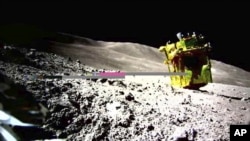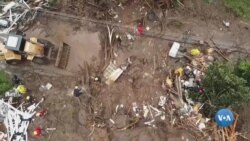ຍານສຳຫຼວດດວງຈັນທຳອິດຂອງຍີ່ປຸ່ນ ໄດ້ລອດຊີວິດເປັນຄັ້ງທີ່ສາມຈາກຄ່ຳຄືນທີ່ໜາວເຢັນສຸດຂອງດວງຈັນ ອົງການອະວະກາດຂອງຍີ່ປຸ່ນ ຫຼື JAXA ໄດ້ກ່າວໃນຕອນແລງ ວັນພຸດມື້ນີ້ ຫຼັງຈາກທີ່ໄດ້ຮັບພາບຖ່າຍນຶ່ງ ຈາກອຸປະກອນຂອງຍານດັ່ງກ່າວ ພາຍຫຼັງທີ່ໄດ້ບິນລົງຈອດດວງເດືອນເມື່ອສາມເດືອນກ່ອນ ອີງຕາມອົງການຂ່າວເອພີ.
ຍານສຳຫຼວດນີ້ ເອີ້ນວ່າ Smart Lander for Investing Moon ຫຼືມີຊື່ຫຍໍ້ວ່າ SLIM ໄດ້ໄປລົງຈອດໃນພື້ນຜິວຂອງດວງຈັນ ເມື່ອວັນທີ 20 ມັງກອນ ເຮັດໃຫ້ຍີ່ປຸ່ນ ເປັນປະເທດທີຫ້າ ທີ່ໄດ້ສົ່ງຍານອະວະກາດສຳຫຼວດໄປຍັງດວງຈັນ.
SLIM ໄດ້ບິນລົງຈອດຜິດພາດເຮັດໃຫ້ອ່ຽງຂ້າງໂດຍໃນເບື້ອງຕົ້ນ ແປ້ນເກັມແສງຕາເວັນບໍ່ສາມາດຫັນໄປຫາດວງຕາເວັນ ແລະກໍໄດ້ຖືກປິດການທຳງານພາຍໃນບໍ່ເທົ່າໃດຊົ່ວໂມງ ແຕ່ກໍໄດ້ເປີດຄືນເມື່ອດວງຕາເວັນຂຶ້ນແປດມື້ຕໍ່ມາ. SLIM ເຊິ່ງໄດ້ຮັບໜ້າທີ່ໃນການທົດສອບເຕັກໂນໂລຈີການລົງຈອດທີ່ແມ່ນຢຳຂອງຍີ່ປຸ່ນ ແລະການເກັມກຳເອົາຂໍ້ມູນດ້ານທໍລະນີສາດ ແລະຮູບພາບຕ່າງໆ ແຕ່ບໍ່ໄດ້ຖືກອອກແບບມາເພື່ອຢູ່ລອດຄ່ຳຄືນຂອງດວງຈັນ.
JAXA ໄດ້ກ່າວຢູ່ໃນສື່ສັງຄົມ X ວ່າ ໜ້າທີ່ຫຼັກໆຂອງ SLIM ແມ່ນກໍຍັງທຳງານຢູ່ ເຖິງແມ່ນວ່າ ມັນໄດ້ປະສົບກັບຮອບການປ່ຽນແປງຂອງອຸນຫະພູມທີ່ໂຫດຮ້າຍຊ້ຳແລ້ວຊ້ຳອີກກໍຕາມ. ອົງການນີ້ ໄດ່ກ່າວວ່າ ຕົນວາງແຜນທີ່ຈະຕິດຕາມເບິ່ງການຫລຸ້ນຫ້ຽນຂອງຍານອະວະກາດຢ່າງໃກ້ຊິດ.
ບັນດານັກວິທະຍາສາດ ຫວັງວ່າ ຈະພົບເຫັນຮ່ອງຮອຍກ່ຽວກັບຕົ້ນກຳເນີດຂອງດວງເດືອນ ດ້ວຍການປຽບທຽບອົງປະກອບແຮ່ທາດຫີນຕ່າງໆຂອງດວງເດືອນກັບຫີນທັງຫຼາຍຂອງໂລກ.
ຂໍ້ຄວາມຈາກ SLIM ຖືກສົ່ງມາບໍ່ເທົ່າໃດວັນ ຫຼັງຈາກ ອົງການນາຊ້າ (NASA) ໄດ້ຟື້ນຟູການຕິດຕໍ່ກັບຍານອະວະກາດ ໂວຍເອເຈີ ນຶ່ງ (Voyager 1) ທີ່ເປັນຍານສຳຫຼວດທີ່ຢູ່ຫ່າງໄກທີ່ສຸດຈາກໂລກ ເຊິ່ງໄດ້ສົ່ງຂໍ້ມູນສັນຍານທີ່ບໍ່ແຈ່ມແຈ້ງ ກັບຄືນມາຍັງໂລກເປັນເວລາຫຼາຍເດືອນ.
ຍານສຳຫຼວດຂອງສະຫະລັດ ທີ່ໄດ້ສ້າງຂຶ້ນໂດຍບໍລິສັດອະວະກາດຂອງເອກະຊົນ ໄດ້ປະກາດການຍຸຕິປະຕິບັດງານຂອງຕົນ ນຶ່ງເດືອນພາຍຫຼັງທີ່ໄດ້ບິນລົງຈອດທີ່ດວງຈັນ ໃນເດືອນກຸມພາ ປີ 2023 ແລ້ວບໍ່ສາມາດຕິດຕໍ່ສື່ສານກັບຍານສຳຫຼວດນັ້ນໄດ້.
Japan’s first moon lander has survived a third freezing lunar night, Japan’s space agency said Wednesday after receiving an image from the device three months after it landed on the moon.
The Japan Aerospace Exploration Agency said the lunar probe responded to a signal from the earth Tuesday night, confirming it has survived another weekslong lunar night.
Temperatures can fall to minus 170 degrees Celsius during a lunar night and rise to around 100 Celsius during a lunar day.
The probe, Smart Lander for Investing Moon, or SLIM, reached the lunar surface on Jan. 20, making Japan the fifth country to successfully place a probe on the moon.
SLIM landed the wrong way up with its solar panels initially unable to see the sun, and had to be turned off within hours, but powered on when the sun rose eight days later.
SLIM, which was tasked with testing Japan's pinpoint landing technology and collecting geological data and images, was not designed to survive lunar nights.
JAXA said on the social media platform X that SLIM's key functions are still working despite repeated harsh cycles of temperature changes. The agency said it plans to closely monitor the lander's deterioration.
Scientists are hoping to find clues about the origin of the moon by comparing the mineral compositions of moon rocks and those of Earth.
The message from SLIM came days after NASA restored contact with Voyager 1, the farthest space probe from Earth, which had been sending garbled data back for months.
An U.S. lunar probe developed by a private space company announced termination of its operation a month after its February landing, while an Indian moon lander failed to establish communication after touchdown in 2023.











ຟໍຣັມສະແດງຄວາມຄິດເຫັນ